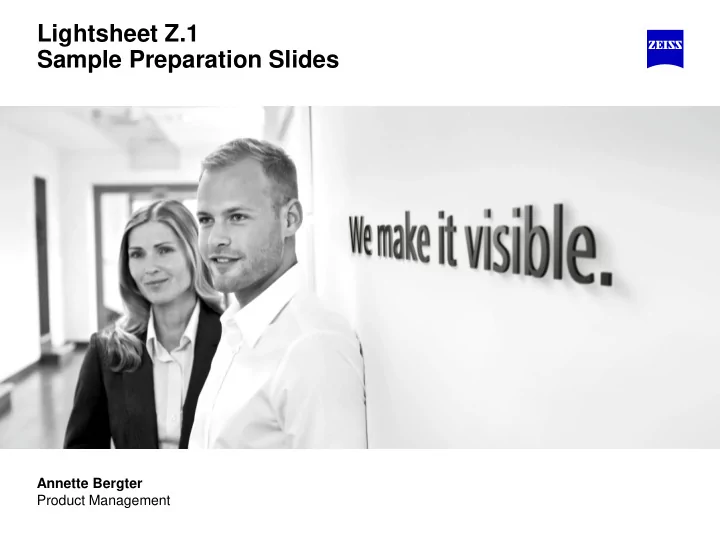

Lightsheet Z.1 Sample Preparation Slides Annette Bergter Product Management
Embedding of larger samples Syringe – Cutting Use 1 ml syringe with the following characteristics: Cut straight just behind the - Soft plastic material for easier cutting orifice opening (red dotted - Without needle line). - Not too prominent printing, which might block the This might take some force . view onto the sample during embedding Use a one sided razor blade or a scalpel for cutting. 19.9.2012 2
Embedding of larger samples Syringe – Embedding Liquid agarose - Concentration: 1-1.5% - Appropriate medium - Fluorescent beads Fine Tweezers Cut Syringe Sample (here green plastiline) 19.9.2012 3
Embedding of larger samples Syringe – Embedding * Fill syringe with agarose. Use the tweezers to For alignment: - Before entering agarose, introduce the sample into - Rotate syringe slowly the plunger pokes out of the agarose horizontally the syringe (red star) to -Use a dissecting prevent air bubbles needle - Enter liquid agarose and - The agarose will pull the plunger to fill harden within minutes about 0.5 to 1 cm 19.9.2012 4
Embedding of larger samples Syringe – Embedding Extra agarose at To remove the agarose: The sample is the end will - Pull the sample back, the ready for imaging destabilize the extra agarose sticking out sample during - Cut along the syringe imaging opening 19.9.2012 5
Embedding of larger samples Syringe – Embedding Depression Slide or watch glass 1 – 1.5% Cut Adult Drosophila Tweezers syringe in 70% EtOH or agarose or Preparation 50% glycerol needle 6
Embedding of larger samples Syringe – Embedding Place the fly with the tweezers in Use tweezers or Cut off extra the depression slide removing all preparation needle to agarose. The extra liquid with a pipette. align the fly within the fly is ready agarose. for imaging. Use the syringe to fill the depression with liquid agarose and immediately suck the agarose with the fly back into the syringe. 7
Embedding of larger samples Mounting Chamber The mounting chamber is The syringe is modified* so removed by pressing the a metal rod of the wanted rod out and cutting along diameter is at the front of the edge of the syringe with the plunger (here an O-ring, a tweezers. red arrow). Agarose concentration: 1.5%. If too low, the walls won’t be stable. Phytagel: stable and good optical characteristics The chamber can be used for incubation in specific The agarose can be poured medium, or to grow into the syringe or suck into plants. the syringe using the For imaging the mounting plunger. chamber is held by a syringe or the same Sample Holder diameter. * Flood P.M., Kelly R., Gutiérrez-Heredia L. and E.G. Reynaud School of Biology and Environmental Science, University College Dublin, Ireland 8
Embedding in Capillaries Medium sized samples Capillary 0.5-1% liquid agarose Sample size should be - Appropriate medium no more than 2/3 and no - Fluorescent beads less than 1/3 of the capillary diameter Plunger The following show a zebrafish embryo, similar procedure as well for e.g. Drosophila embryos. For smaller samples a steromicroscope during embedding can be useful.
Embedding in Capillaries Medium sized samples Place the sample in an eppendorf tube, remove all medium. Add liquid agarose (ca. 200µl) into the eppendorf tube to the zebrafish. Before dipping the capillary with plunger into the agarose, make sure the plunger sticks out a bit (red arrow) to prevent air bubbles.
Embedding in Capillaries Medium sized samples Bring the capillary close to the Move the plunger upwards to suck in sample. some agarose, before sucking in the sample. Proceed gently to not damage the Take the capillary out of the eppendorf sample at the edge of the capillary tube when the sample is embedded. while it enters. Hold the capillary Start rotating the capillary, while holding it horizontally if necessary. horizontally until agarose is solid. Cut off extra agarose . 11
Hanging Samples Hook or surgery clamp Samples can be placed on a hook*, that is fastened to a capillary. The Lightsheet Z.1 sample holder can be used. Samples can be attached by a surgery clamp*, that is fastened to a syringe. The Lightsheet Z.1 sample holder can be used. Be aware: The rotation of the sample is not centered and it might therefore collide with the detection optics. The hook or clamp will damage the sample and might cast shadows or block the light during imaging. * Flood P.M., Kelly R., Gutiérrez-Heredia L. and E.G. Reynaud School of Biology and Environmental Science, University College Dublin, Ireland 12
Recommend
More recommend